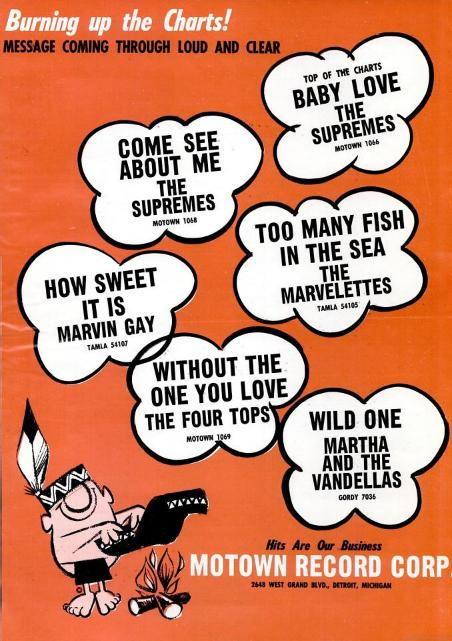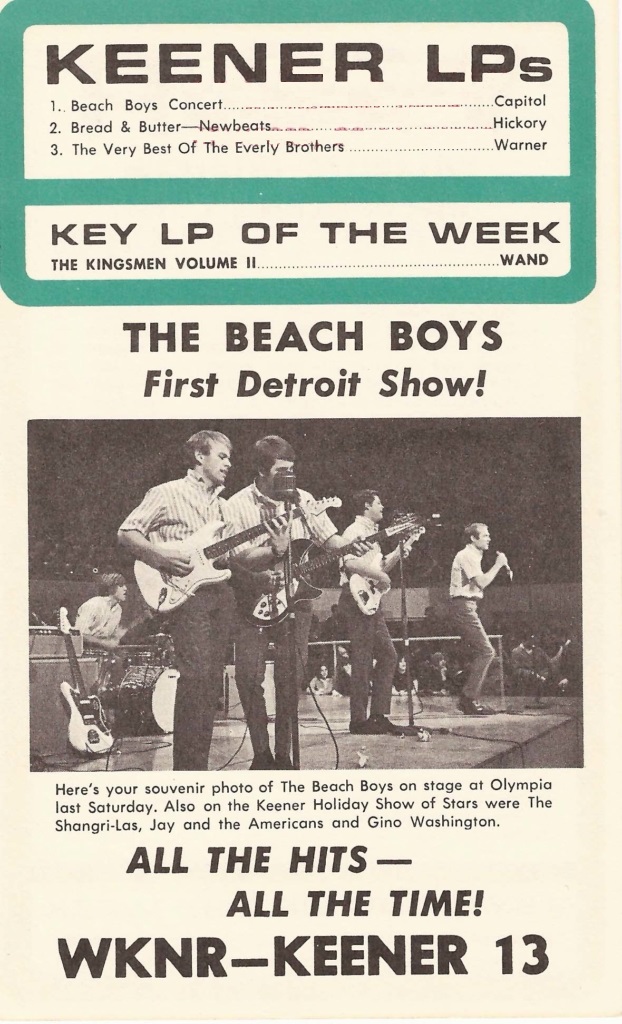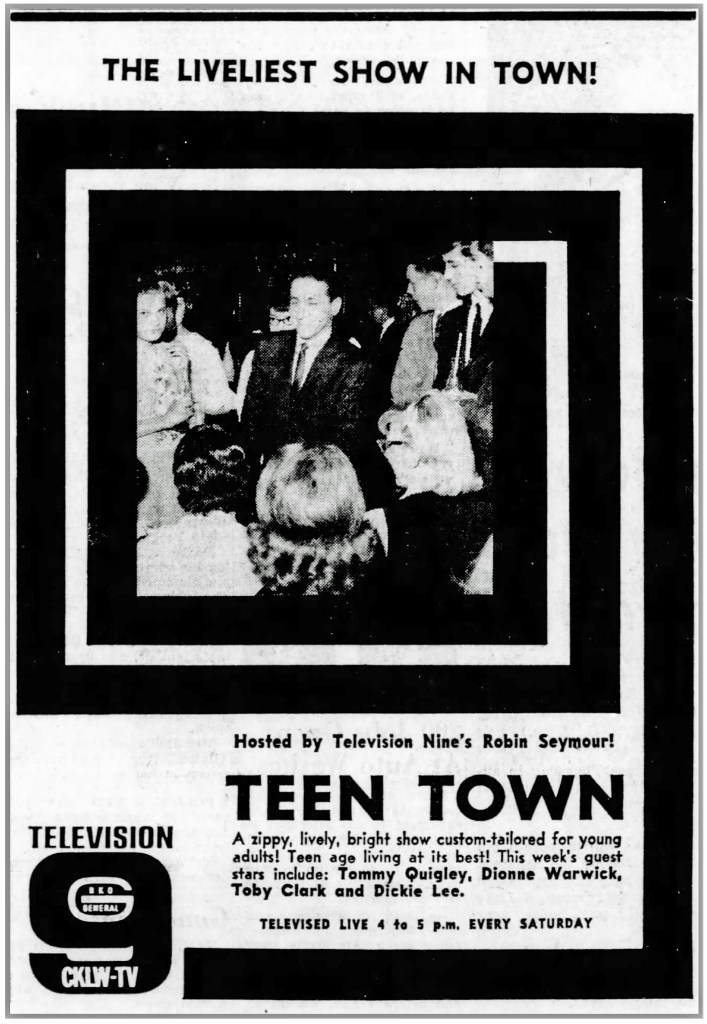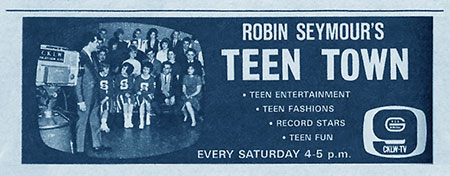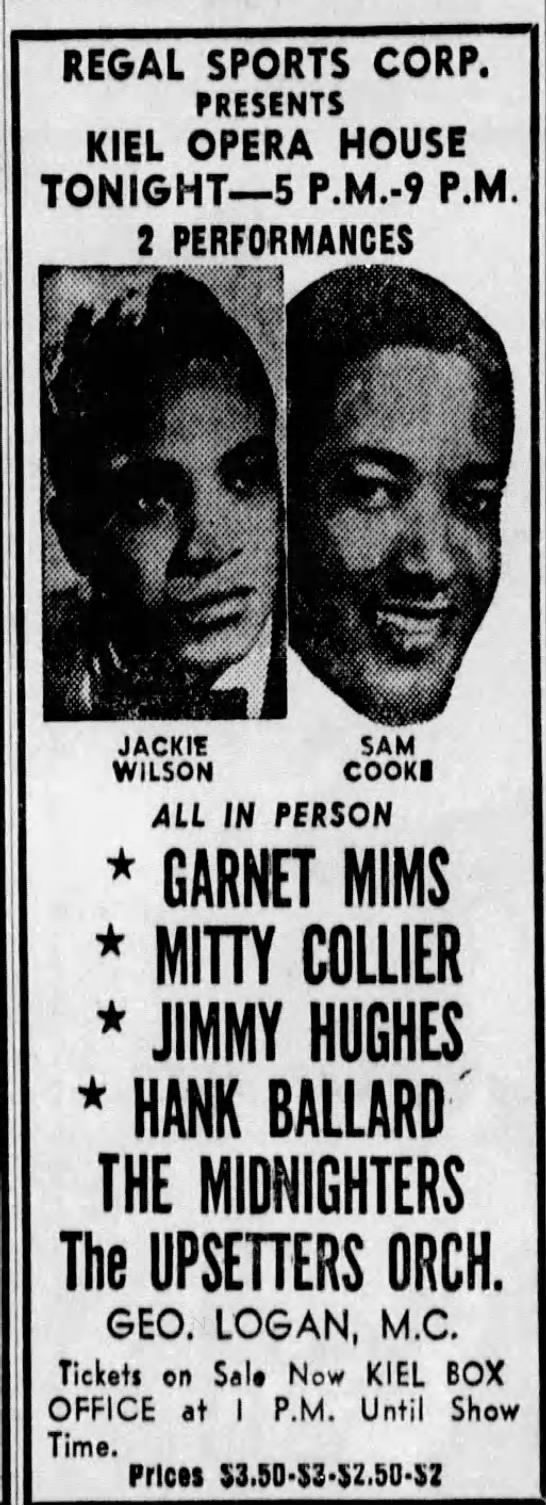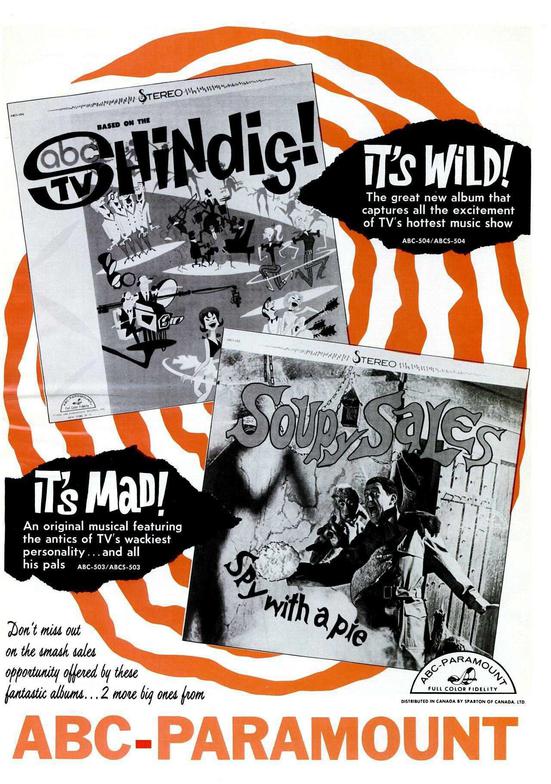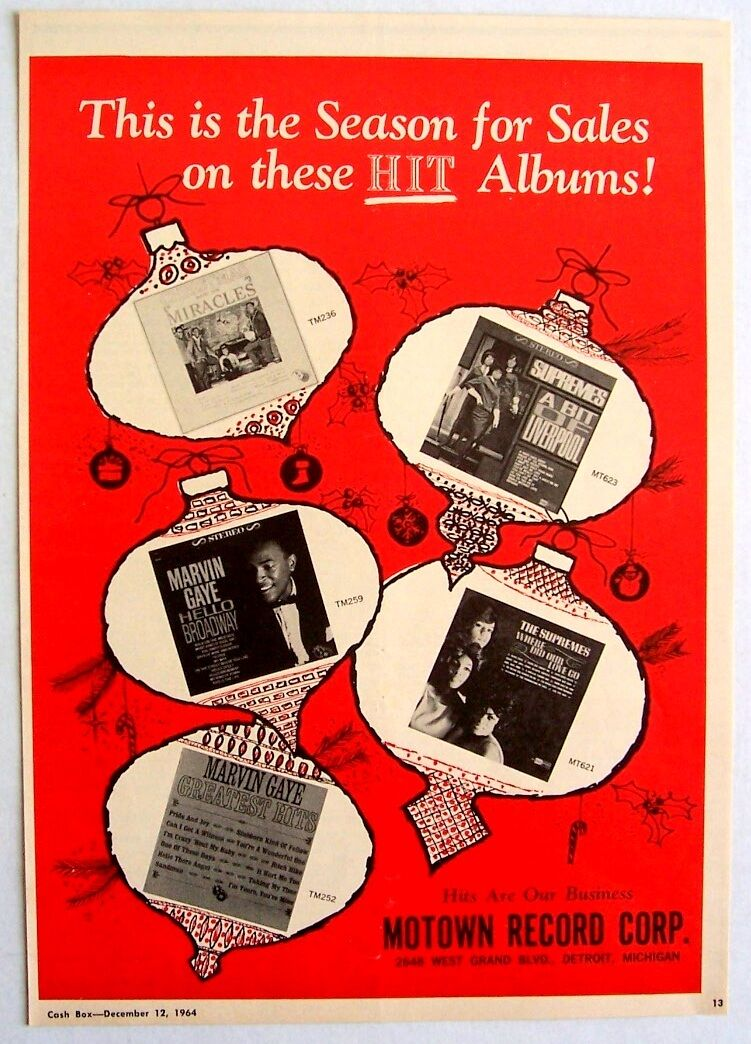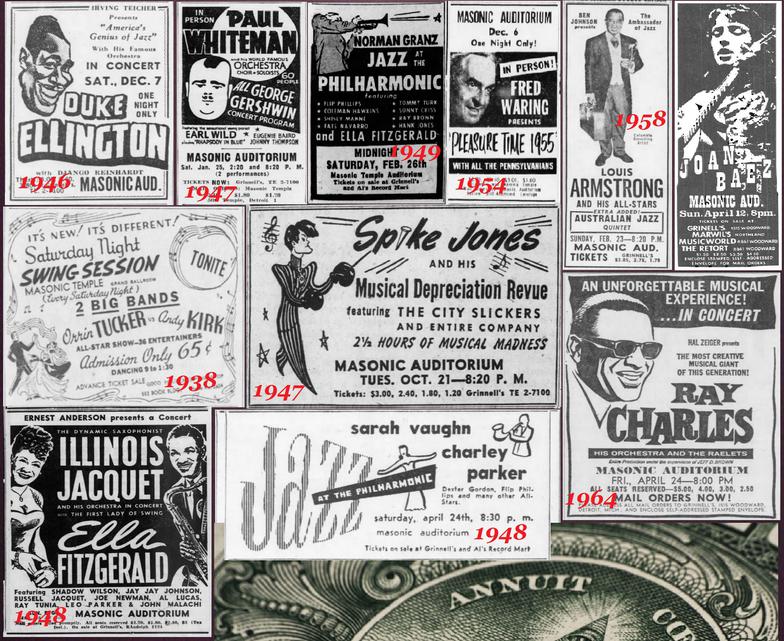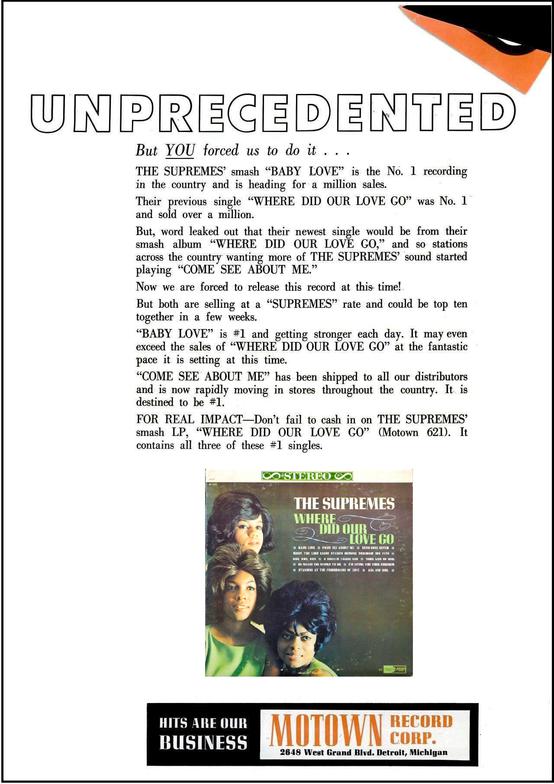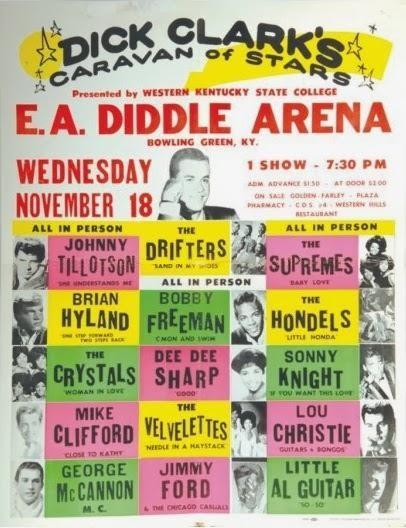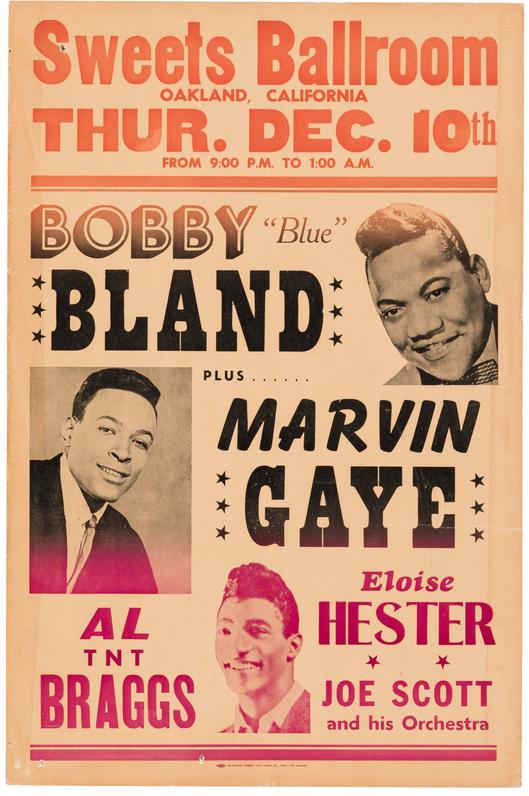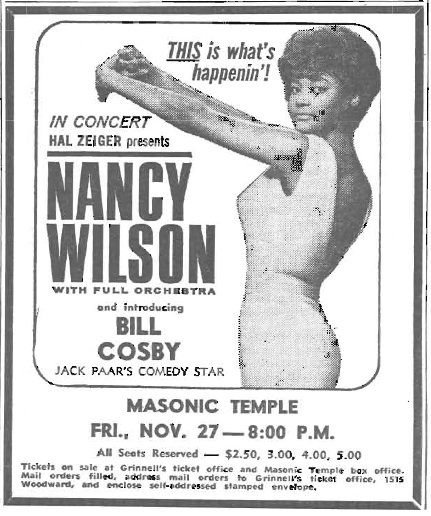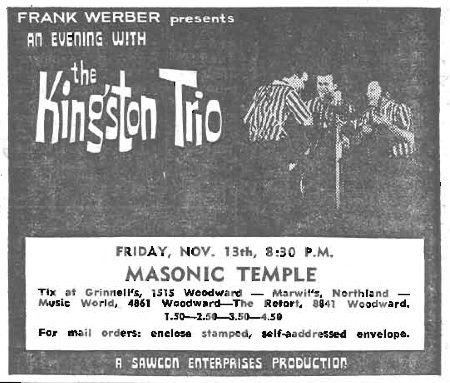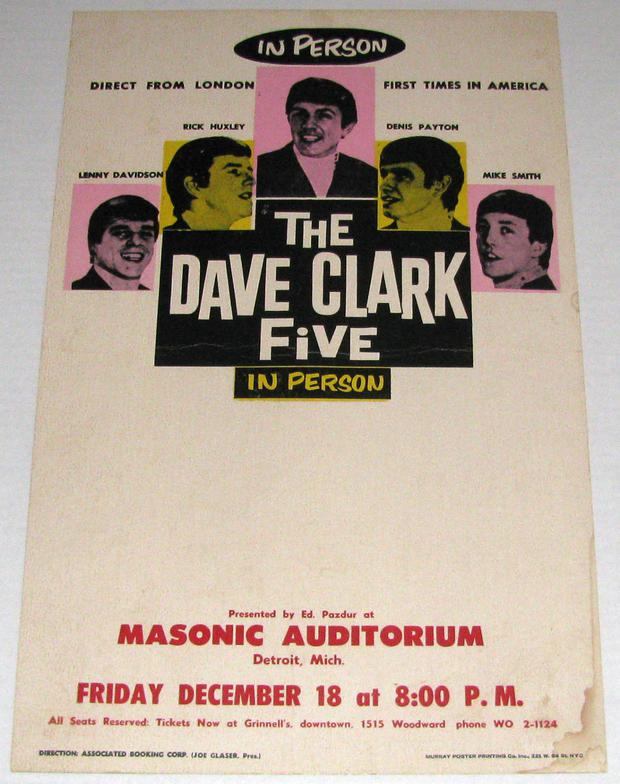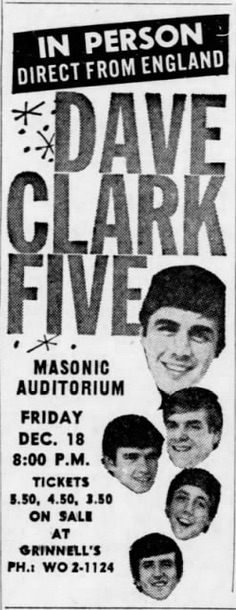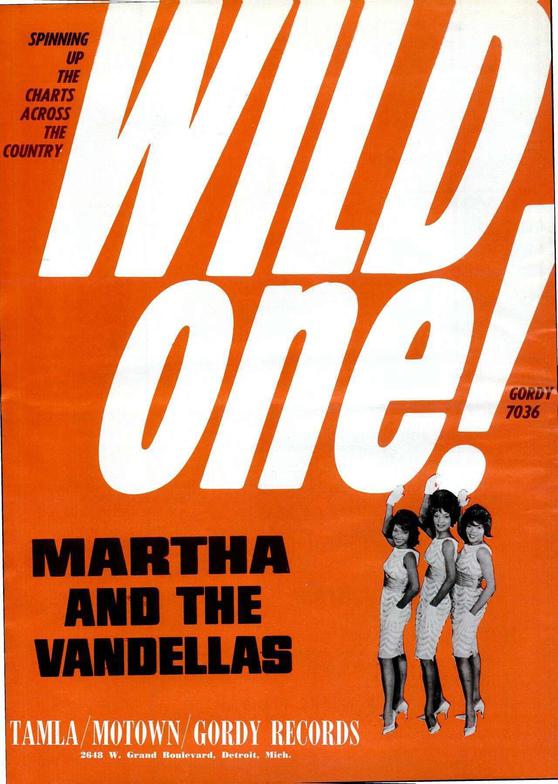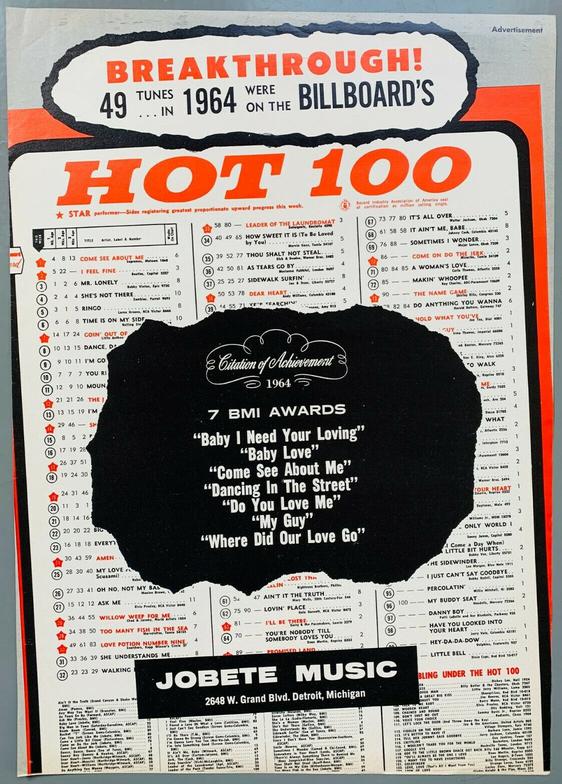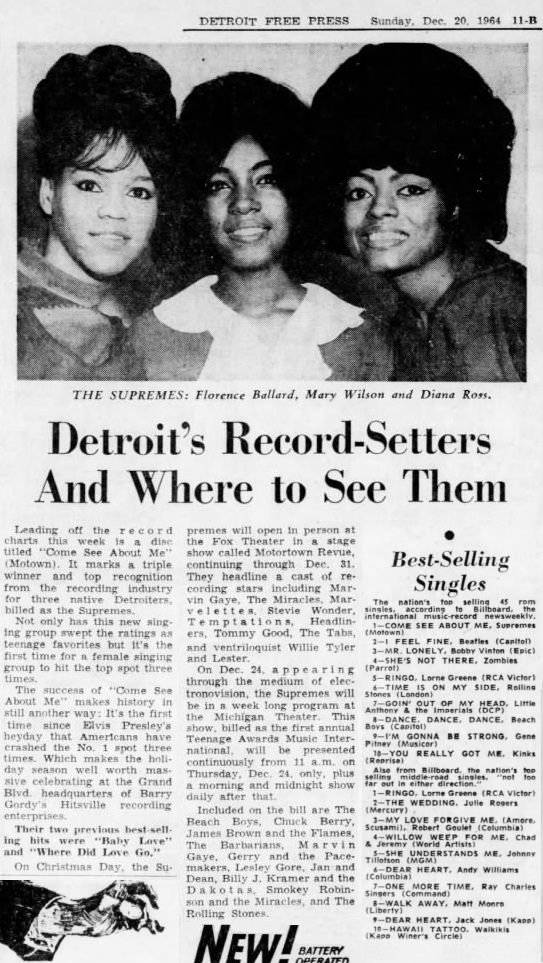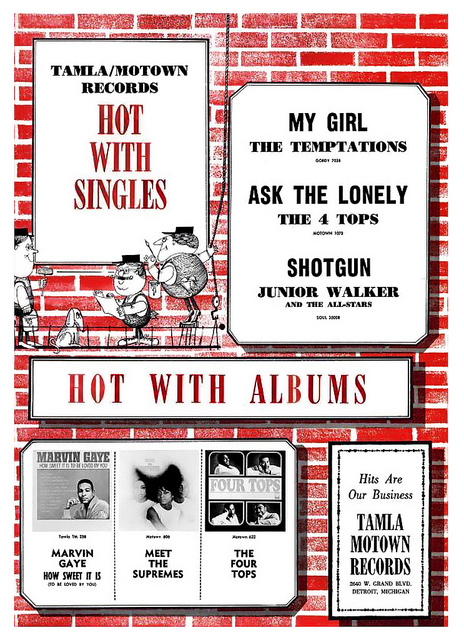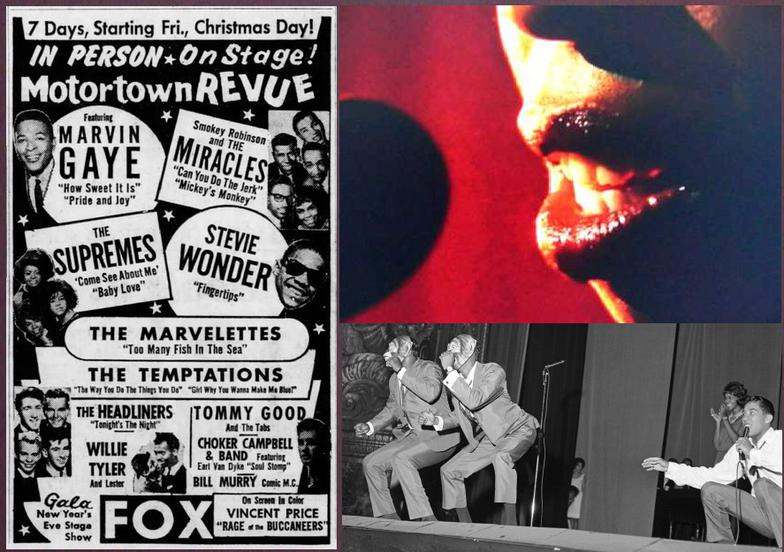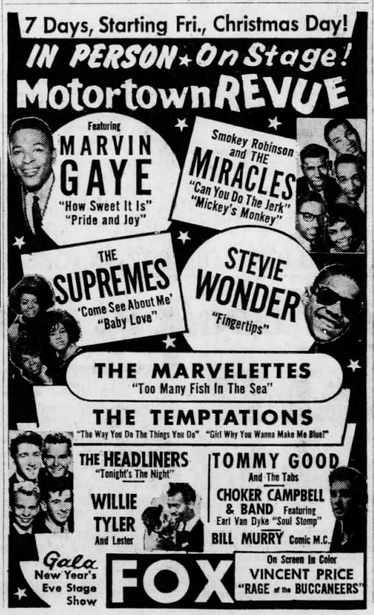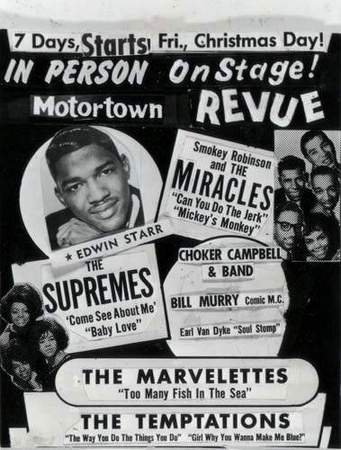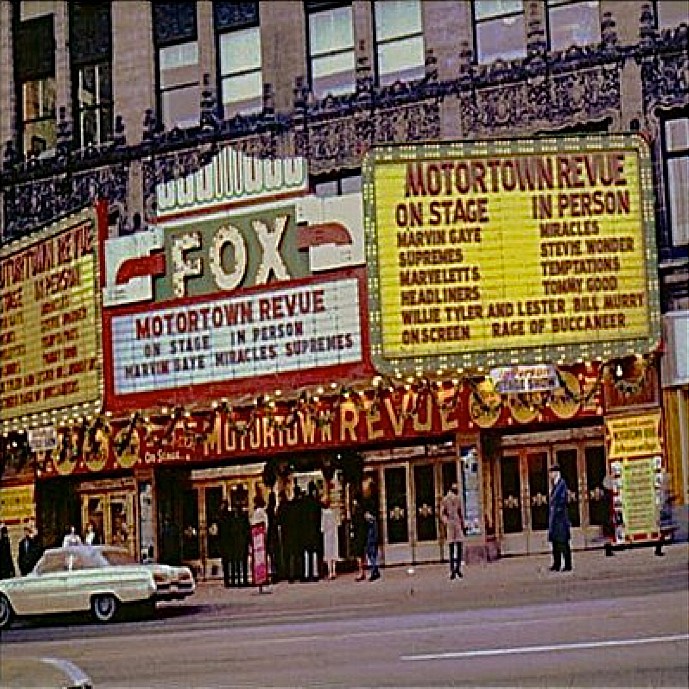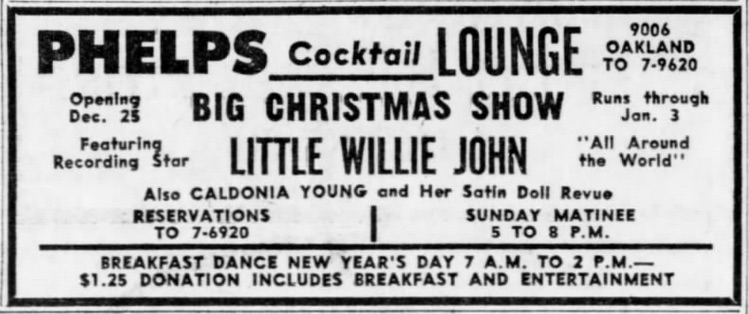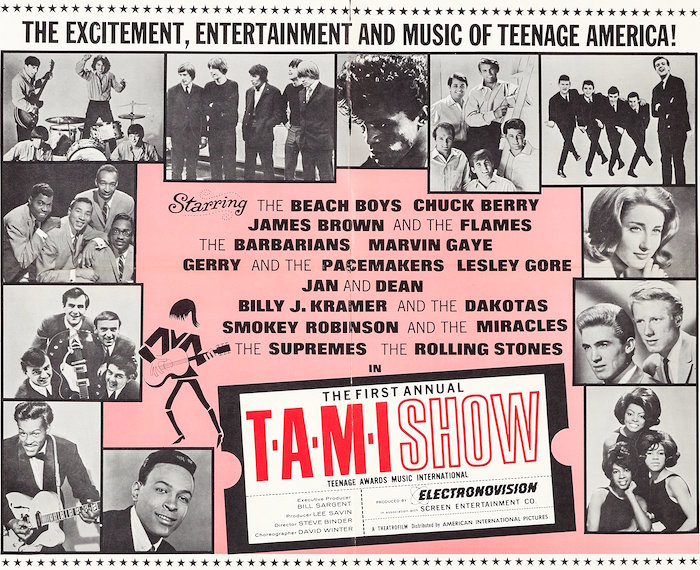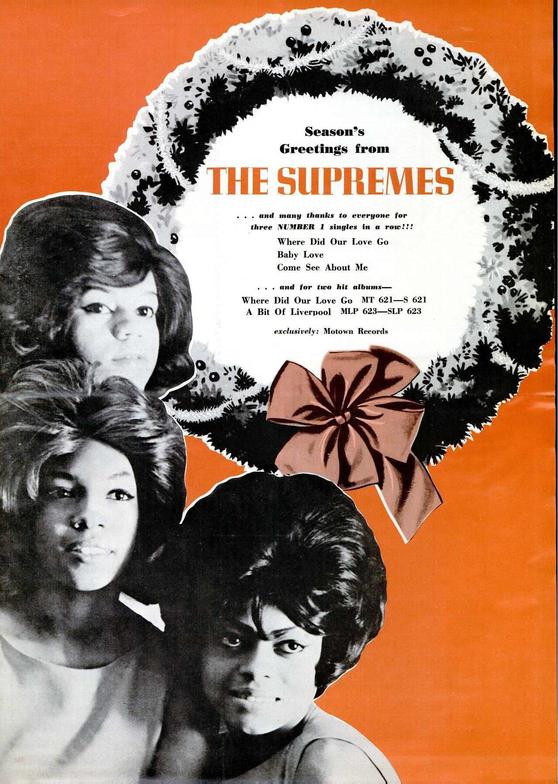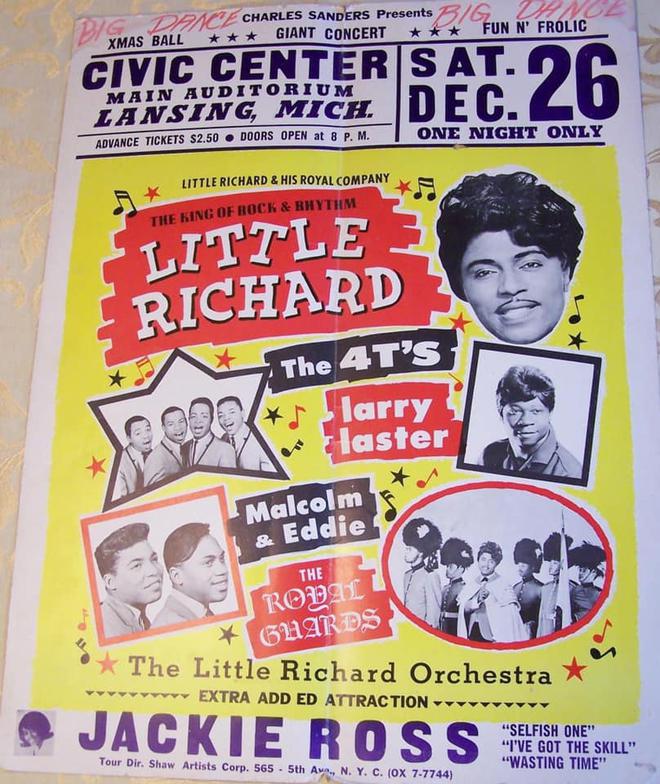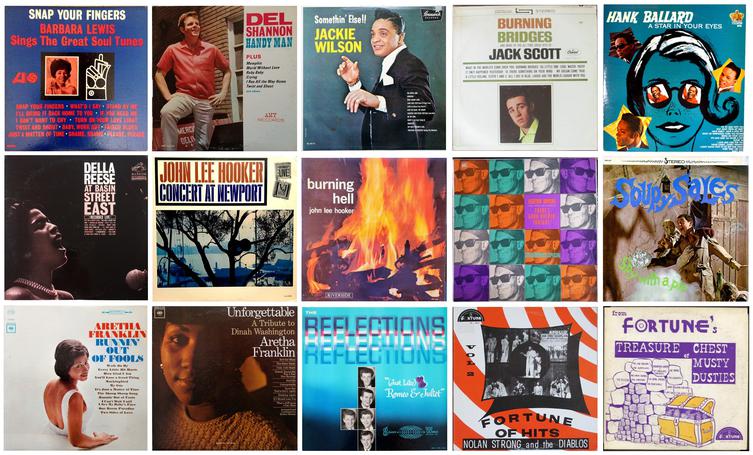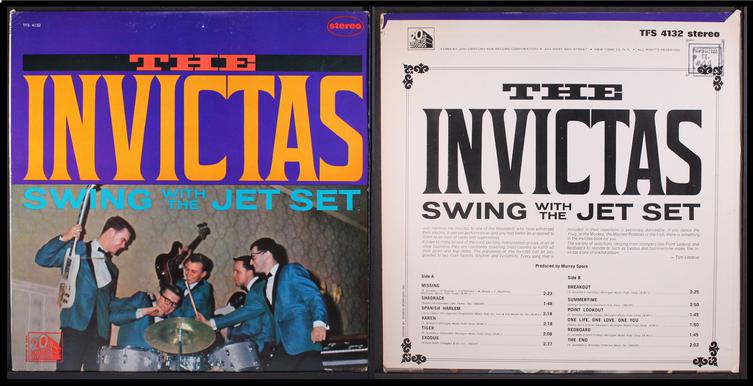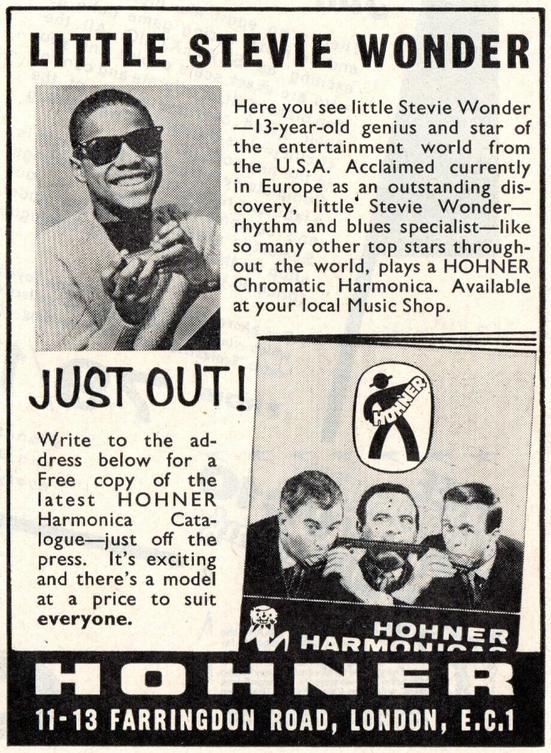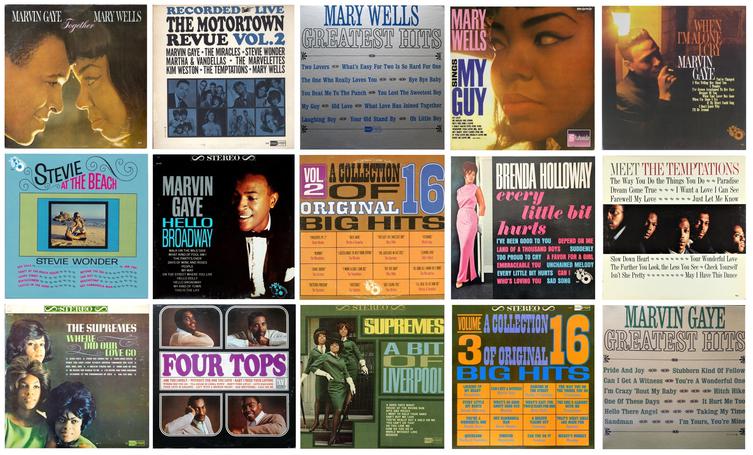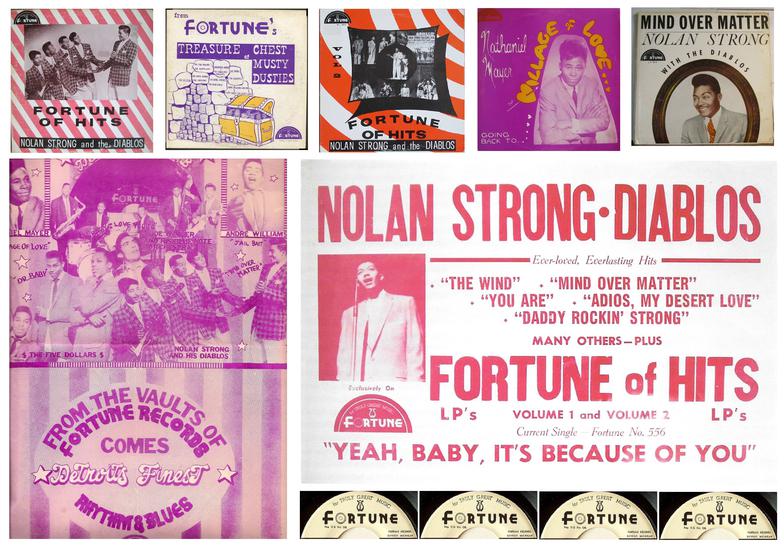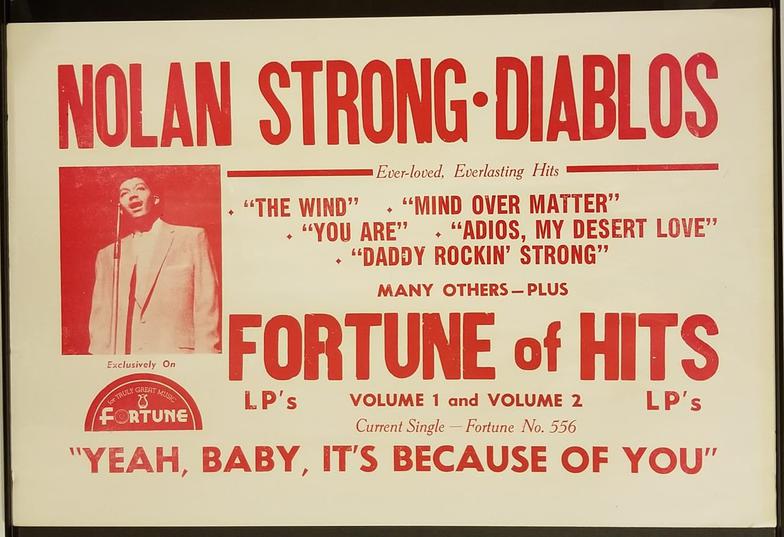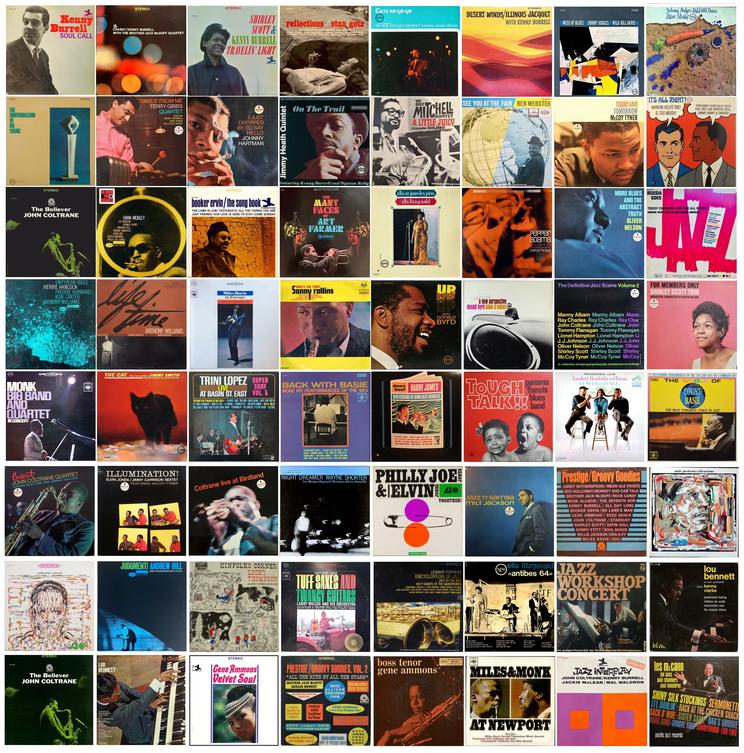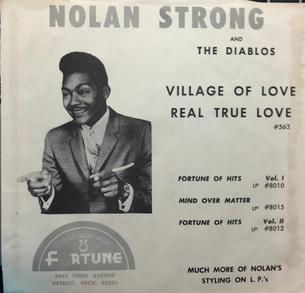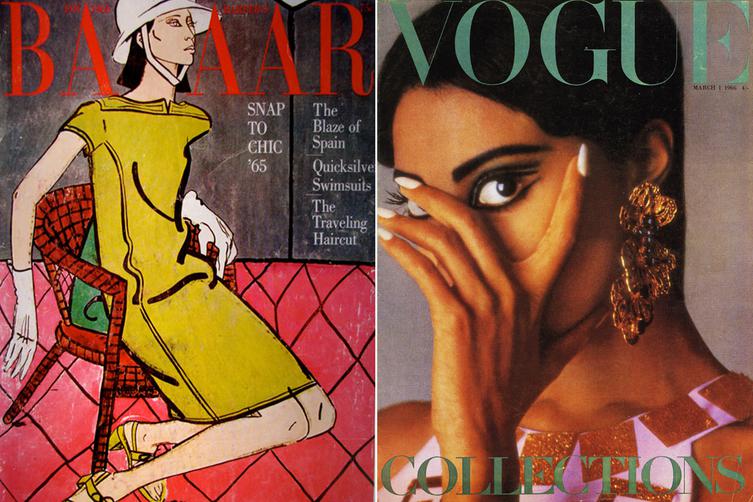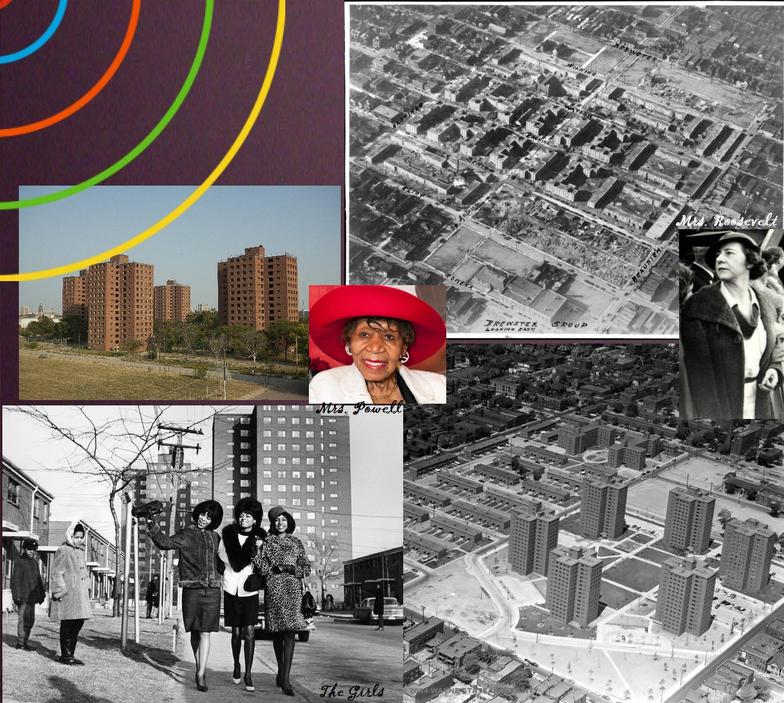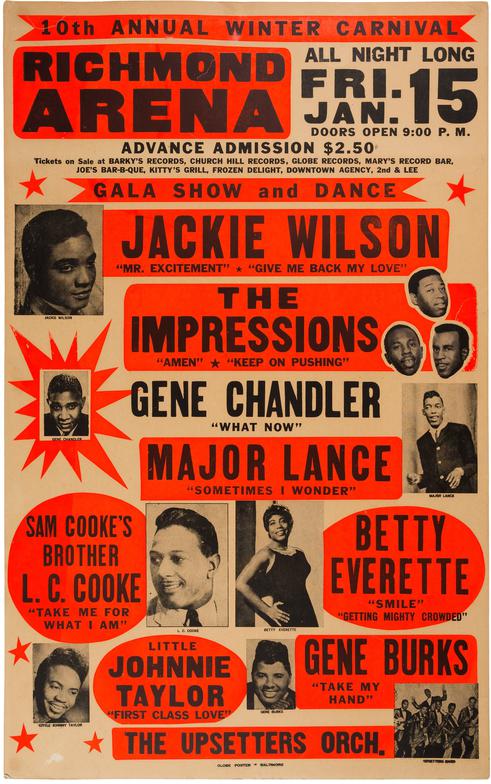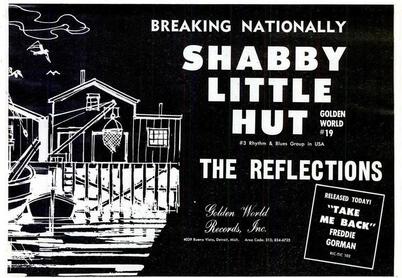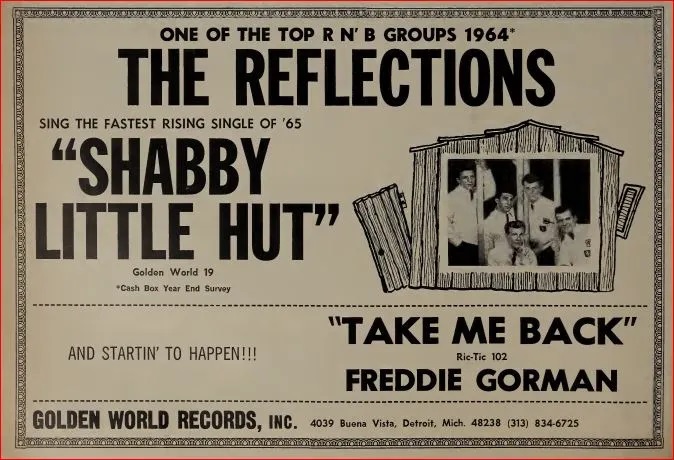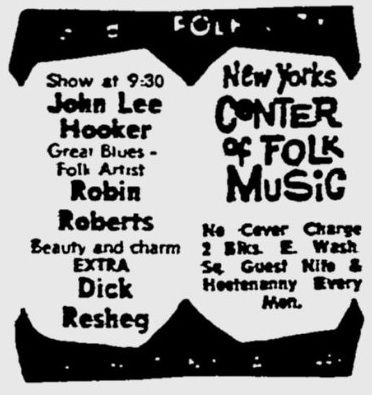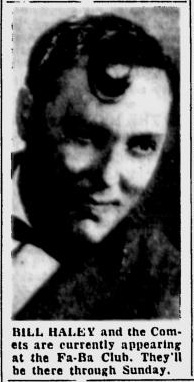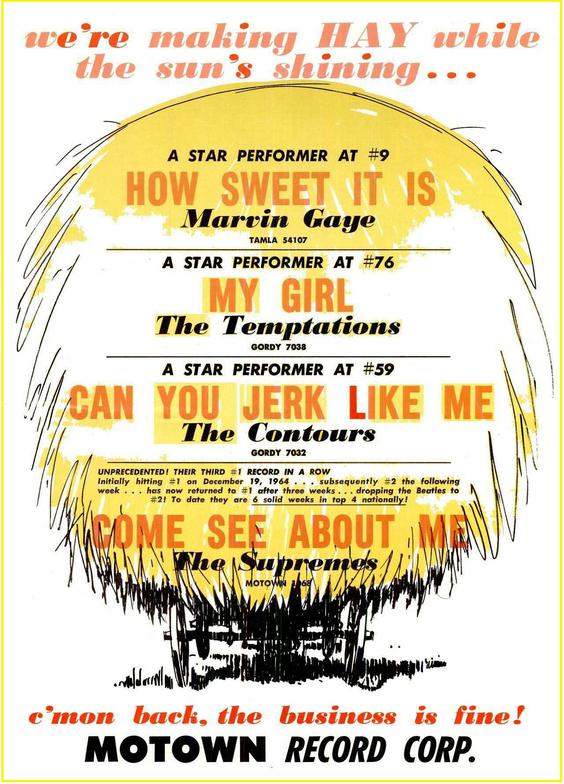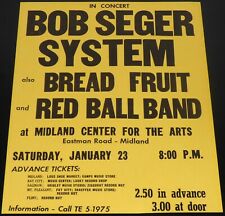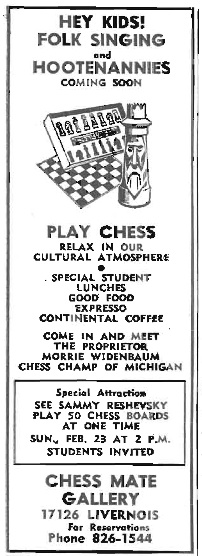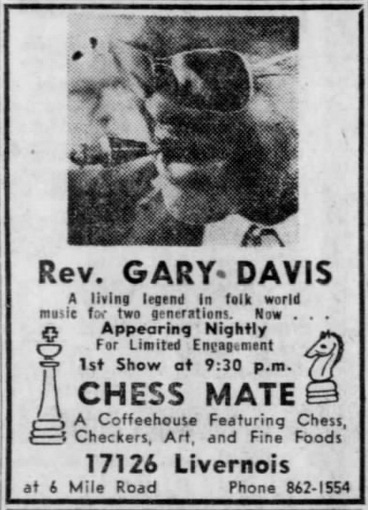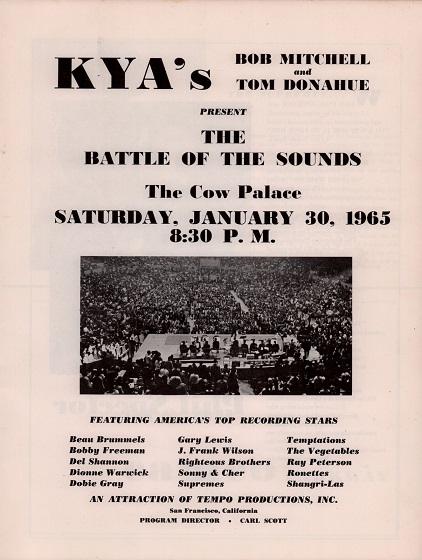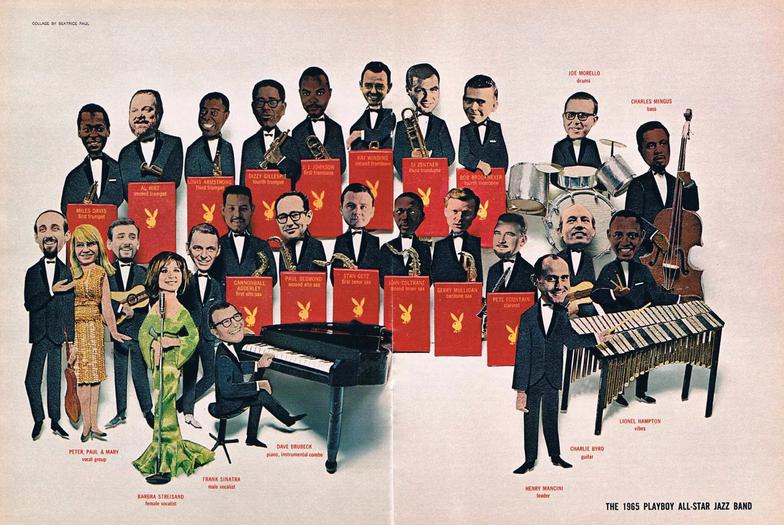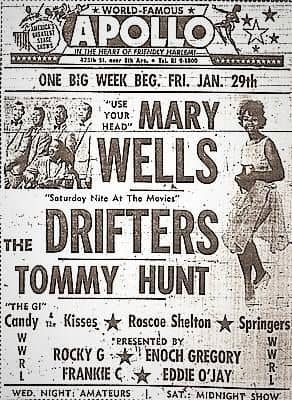Splatt Gallery
Double click here to add text.
Splatt Gallery's History of Michigan Music Posters
Volume Two - 1964-1966 - Page Four
***********************************************************
Volume Two - 1964-1966 - continues - HERE
Full-page ad in the November 28, 1964 issue of Billboard Magazine for Motown Records. On the week of this issue, The Supremes song “Baby Love” was knocked off the #1 spot on the Hot 100 chart, after a four week run, by “Leader of the Pack” by The Shangri-Las. The Supremes’ “Come See About Me” would hit #1 three weeks later, on December 19th. Eight days later, on December 27, 1964, The Supremes made their first of what would become seventeen appearances on the Ed Sullivan TV show, performing “Come See About Me”.
The Supremes – Come See About Me (1964)
https://www.youtube.com/watch?v=NoOsosfBrnw
The back side of the WKNR Keener-13 Music Guide with a photo from the Beach Boys’ first Detroit appearance, at the Olympia Stadium on November 28, 1964. They had already made their first Michigan appearance four months earlier, in Flint on July 20, 1964.
December 5, 1964 ad for the Teen Town TV show, co-produced by DJ Robin Seymour and Art Cervi, better known as Bozo the Clown. The show would eventually become the Swingin’ Time TV show.
A TV Guide listing for Robin Seymour’s Teen Town show.
Newspaper ad with Jackie Wilson and Hank Ballard & the Midnighters, along with Sam Cooke and others, at the Kiel Opera House in St. Louis, Missouri on December 11, 1964.
A full-page ABC-Paramount Records ad in the December 12, 1964 issue of Billboard magazine for the second album by Soupy Sales, called “Spy With A Pie”.
A full-page Motown Records ad in the December 12, 1964 issue of Cash Box magazine.
Masonic Auditorium is Detroit’s oldest entertainment venue that is still operating today under its original name and location. Located within the world’s largest Masonic temple, it opened in 1926 and is still one of the largest theater stages in the country. It was the premier venue for the big Jazz shows since the 1930’s, gradually incorporating folk and pop music. The first rock and roll show was the appearance of the Dave Clark Five on December 18, 1964.
A full-page Motown Records ad in the November 7, 1964 issue of Billboard magazine for the second album by the Supremes.
From Wikipedia: “With the release of this album, The Supremes became the first act in Billboard magazine history to have three number-one hits from the same album. It was the album that introduced "The Motown Sound" to the masses. It was also, at the time, the highest-ranking album by an all-female group. It remained in the #2 position for 4 consecutive weeks in January 1965, shut out of the top spot by the Beatles' blockbuster Beatles '65 album. “Where Did Our Love Go” remained on the Billboard album chart for an unprecedented 89 weeks.”
Poster for Dick Clark’s Caravan of Stars show in Bowling Green, Kentucky, November 18, 1964, with Motown represented by the Supremes and the Velvelettes.
A Tilghman Press poster for Marvin Gaye with Bobby “Blue” Bland, Al TNT Braggs, Eloise Hester and the Joe Scott Orchestra in Oakland, California on December 10, 1964.
An ad for Nancy Wilson at the Masonic Temple in Detroit on November 27, 1964, her 50th Michigan appearance. It was comedian Bill Cosby’s first Michigan appearance.
An ad for folk singer Pete Seeger, in his 7th Michigan appearance, at the Masonic Temple in Detroit on November 15, 1964.
An ad for folk singers Kingston Trio, in their 6th Michigan appearance, at the Masonic Temple in Detroit on November 13, 1964.
The Dave Clark Five made their first Detroit appearance at Masonic Auditorium, December 18, 1964, a month earlier they had made their first Michigan appearance in Lansing. The DC5 were the direct rivals to The Beatles, boasting the “Tottenham Sound” in response to the Beatles’ Mersey Beat. Their single “Glad All Over” knocked “I Want to Hold Your Hand” off the #1 spot on the UK charts, they were the second “British Invasion” band featured on the Ed Sullivan show, following the Beatles, and they made a movie, “Catch Us if You Can” to compete with “A Hard Day’s Night”. Poster by an unknown artist.
The Dave Clark Five – Glad All Over (1964)
https://www.youtube.com/watch?v=EipdAjhImrc
A full-page Motown Records ad in the December 19, 1964 issue of Billboard magazine for the single “Wild One”, the fifth Top 40 single by Martha & the Vandellas.
Martha & the Vandellas – Wild One (1964)
https://www.youtube.com/watch?v=9qjuNv_unhc
A full-page ad from Jobete Music, the publishing arm of Motown Records noting their success in 1964, with a total of 49 songs that made the Billboard Hot 100 singles chart during the year. The chart shown is from the week of December 19, 1964, with the Supremes’ “Come See About Me” sitting at #1. It would be knocked out of the top spot by “I Feel Fine” by the Beatles, but would rebound and return to #1 on January 16, 1965.
A story in the December 20, 1964 edition of the Detroit Free Press newspaper noting the historical significance of the Supremes’ third #1 single in a row. The article also describes the first annual Christmas week Motortown Revue at the Fox Theater in Detroit, and the week-long screening of the now-legendary T.A.M.I. show at the Michigan Theater
A full-page Tamla Motown Records ad with the single “My Girl” by the Temptations, released on December 21, 1964, their 11th single and first #1 on the Hot 100 Chart, second #1 on the R&B Singles chart.
Also advertised is the single “Ask The Lonely” by the Four Tops, their third single and first Top Ten on the R&B Singles chart, and peaking at #24 on the Hot 100 chart, short of their 1964 debut “Baby I Need Your Loving” which reached #11 on the Hot 100 chart but did not chart on the R&B Singles chart.
The third advertised single is “Shotgun” by Junior Walker & the All Stars, their fifth single and first to chart, impressively at #1 on the R&B Singles chart and #4 on the Hot 100 chart.
Albums being advertised are “How Sweet It Is” by Marvin Gaye, his fifth album; a re-issue of the Supremes’ debut “Meet The Supremes”, and the debut album by the Four Tops.
1964 was a break-out year for Motown. Finally (finally) groups that Berry Gordy had maintained faith in that had failed to have a hit for years (groups like The Temptations, The Supremes, and house drummer Marvin Gaye) scored Top Ten records. For the first time of what would become a four-year tradition, the year ended with the Motortown Revue Christmas shows at the Fox Theater. And once again, if you didn’t think you would get your money’s worth for the $3 admission just to see about a dozen Motown acts, you also got a movie (this year’s was “Rage of the Buccaneers”, starring Vincent Price). Alas, this would be the end of an era, as BillBoard reported that concert venues were beginning to drop the feature movies.
One of MC’s for these shows was the freshest new voice on the radio, Martha Jean “The Queen” Steinberg on WCHB. Martha Jean was born in Memphis, Tennessee where she led the typical normal life of marrying after high school and having five kids. Eventually she went to work at the local radio station library and found herself on the air, again following the typical role for the few females on the radio, hosting a cooking and housekeeping show. Since she really wasn’t much on cooking or cleaning, she began interspersing R&B records with a sassy delivery (“I’ve got somethin’ right here that I just know you’re gonna like”).
While in Memphis for a convention, WCHB owner Dr. Wendell Cox, heard her on the radio and convinced her to come to Detroit. She became instantly popular with her humorous down-home advice for women (and for men) and her catch phrase “I bet’cha”. Even beyond the primarily black radio audience of WCHB, “The Queen” was well-known throughout the city.
Marvin Gaye, in his new headlining role, undoubtedly sung his hit, “Can I Get A Witness”, which the Rolling Stones had also performed during their show in Detroit earlier that summer.
Marvin Gaye – Can I Get A Witness (1964)
https://www.youtube.com/watch?v=NJxvJ09DyTE
The first of what would become an annual tradition, when the Motown stars would come home after a year of touring to perform a week-long Motown Revue at the Fox Theater in Detroit, Michigan over the Christmas holiday, for seven days, beginning on December 25, 1964.
Rare appearances by two of Motown’s white acts, the Headliners and Tommy Good.
A second poster for the Christmas 1964 shows at the Fox Theater in Detroit, with Edwin Starr in place of Marvin Gaye. Also missing, from being on the previous poster, are Stevie Wonder, Tommy Good, the Headliners, and Willie Tyler.
An ad for Christmas shows by Little Willie John at Phelps Lounge in Detroit, December 25, 1964 through January 3, 1965.
The Teen Age Music International (T.A.M.I.) show was a two-day concert, October 28-29, 1964 in Santa Monica, California that was filmed and released as a major motion picture on December 29, 1964, just in time for the Christmas movie season. Out of a stellar cast of Motown stars and rock and rollers, James Brown and The Famous Flames stole the show (Keith Richards has said that following that act was the biggest career mistake of The Rolling Stones).
The Michigan acts were Marvin Gaye, Smokey Robinson & the Miracles, and the Supremes.
The house band that backed many of the acts was, as usual, not acknowledged but just as Motown’s Funk Brothers became recognized many years after the fact, this group of musicians in historical retrospect became known as The Wrecking Crew. This same group was responsible for Phil Spector’s famous “Wall of Sound” and included future stars Leon Russell, Glen Campbell, Tommy Tedesco, drummer Hal Blaine, bass player Carol Kaye, and producer Jack Nitzsche.
Here is J.B. schooling everybody from Prince to Bruno Mars on how to do it.
James Brown –T.A.M.I. Show (1964)
https://www.youtube.com/watch?v=grbQv_U4sXI
Christmas greetings from the Supremes, Christmas 1964 in the December 26, 1964 issue of Billboard magazine.
Little Richard’s first Michigan appearance since he returned to rock and roll after his repentant years, headlining this great poster by an unknown artist with his Royal Guards (just a short while before Jimi Hendrix joins the band) at the Civic Center in Lansing, Michigan, December 26, 1964. Helping to establish the year of this show is the appearance of Jackie Ross, listing her hit records, which were all released in 1964, with “Selfish One” reaching as high as #11 on the Billboard Hot 100 chart.
Jackie Ross – Selfish One (1964)
https://www.youtube.com/watch?v=t5g5rSvmTPU
Fifteen albums released by Michigan artists other than Motown in 1964 included three by John Lee Hooker, two by Aretha Franklin, an album by the Reflections which was the only album released by Golden World Records, and two compilation albums from Fortune Records.
Rounding out the list were LP’s by Barbara Lewis, Del Shannon, Jackie Wilson, Della Reese, Hank Ballard, and Soupy Sales.
The Invictas are frequently mentioned as one of the better bands in the teen club circuits, although specific details about them are scant. Dick Wagner (The Frost, Alice Cooper) may have been a member at one time. Adding to the confusion, there was a band from Rochester, New York that was also called The Invictas who, adding further confusion, were known for a song called “The Detroit Move”.
The Invictas were a Detroit-area group who released an entire album (Swing with the Jet Set) in 1964 We are fairly certain though that the album “Swing with the Jet Set” with this haunting instrumental “Missing” is the Detroit version of The Invictas.
The Invictas – Missing (1964)
https://www.youtube.com/watch?v=2KnJ9cqsXsE
Little Stevie Wonder in an ad for Hohner harmonicas, circa 1964.
Fifteen albums released by Motown in 1964 included the debut albums by the Temptations, the Four Tops, and Brenda Holloway. Mary Wells had her most successful year, with the #1 single “My Guy”, a “Greatest Hits” compilation, a duet album with Marvin Gaye, and the opening slot on the Beatles’ UK tour. Ironically, it was her final year with Motown.
Marvin Gaye had four albums, including a “Greatest Hits” compilation, but the most successful was the duet album with Mary Wells. Stevie Wonder’s fifth album was a misguided attempt at surf music. The Supremes had two albums, the Beatles tribute “A Bit of Liverpool” and the breakout “Where Did Our Love Go”.
By 1964, there was already a substantial market for “oldies”, California DJ Art Laboe had been releasing his trademark “Oldies But Goodies” compilation albums as far back as 1959. As the new sounds of Motown and the British Invasion began to dominate the charts, the backlash led to a renewed “Oldies Revival”, as many record collectors and fans still sought out the street corner vocal group harmonies that had become known as “doo-wop”.
The epicenter for the sales of these records was a small shop at a subway station in New York City called Times Square Records. The owners of Times Square Records frequently placed large orders with Detroit’s Fortune Records, prompting Fortune, whose main output were singles, to release a series of albums in rapid succession, with Nathaniel Mayer’s “Going Back To The Village Of Love” album, Nolan Strong with The Diablos album “Mind Over Matter”, a re-issue the 1961 album “Fortune of Hits” by Nolan Strong & the Diablos along with a new “Fortune of Hits Vol 2” by the group and a label compilation titled “Fortune's Treasure Chest Of Musty Dusties”.
A better image of the Fortune Records poster/flyer for the albums “Fortune of Hits” Volume 1 and Volume 2.
Albums released in 1964 that featured our “Class of ‘56” Detroit jazz musicians, Thad Jones, Elvin Jones, Billy Mitchell, Tommy Flanagan, Pepper Adams, Kenny Burrell, Donald Byrd, Curtis Fuller, Doug Watkins, Paul Chambers, and Ron Carter with the likes of Miles Davis, John Coltrane, Count Basie, Herbie Hancock, Thelonious Monk, Trini Lopes, and others, as well as albums under their own names.
1965
The world’s first black supermodel, Donyale Luna, was another graduate of Detroit’s Cass Tech High School. When she started attending Cass Tech she was Peggy Ann Freeman, a skeleton-thin, 5-11 tall, dreamer who was described as “kind of a kook”. It was while in school that she took on her Luna alter-ego, along with grandiose fantasies constructed from various mystery origins, embracing the perception that she was “a weirdo to everyone”.
She took small acting parts in local repertory theaters and was spotted on the street one day by British fashion photographer, David McCabe, who took her to New York City and brought her to Harper’s Bazaar magazine. The magazine was so impressed by her that they immediately hired a sketch artist for the cover portrait on their January 1965 issue and hired photographer, Richard Avedon, to shoot a photo spread for the April issue.
She was an instant toast of the town among the top cognoscenti of New York City, gaining famous friends like Andy Warhol, Miles Davis and Sammy Davis Jr., as she has stated, “I started out at the top.” But the reaction wasn’t quite the same in mainstream America when readers in the south freaked out over the strange, exotic photos of a stunning Zulu warrior and cancelled subscriptions while advertisers pulled out, and William Randolph Hearst prohibited Avedon from photographing her again.
So she left for swinging London, England and became the first black model to appear on the cover of the British Vogue magazine on the March, 1966 issue. And just as in New York, Donyale Luna attracted a circle of celebrity friends such as Michael Caine, Julie Christie and Mia Farrow, while she dated Brian Jones of The Rolling Stones, and appeared in Fellini’s Satyricon. Salvador Dali adored her and declared her “the reincarnation of Nefertiti”.
Miles Davis –Nefertiti (1967)
https://www.youtube.com/watch?v=GAHCg4w3TKs
In 1935, the first federally funded housing project was built in Detroit, creating 700 homes in the five block area bounded by Beaubien, Hastings and Wilkins streets and Mack Avenue. Known as the Brewster project, these new buildings represented a long overdue solution to the dilapidation of the Black Bottom area and the initial groundbreaking ceremony was attended by First Lady Eleanor Roosevelt. The project continued to expand under the name of the Brewster-Douglass project, most dramatically with the addition of six 14-story towers in the 1950’s, becoming the home to nearly 10,000 residents.
There were strict rules for occupancy, including stable employment and family structures, and the community was a safe and thriving environment. Although later, “living in the projects” would have a negative connotation, at their peak the projects were a sign of upward mobility.
Florence Ballard was fifteen years old when her family moved into Brewster-Douglass in 1958 and she began singing in talent shows with her friend Mary Wilson. Mary brought another neighborhood friend, Diane Ross, into their group. In early 1960 the group auditioned at Motown but Berry Gordy told them to come back after they graduated from high school, which they did, agreeing to do anything around the studio from providing handclaps to background vocals.
Under the name that Gordy gave them, The Supremes, they released a succession of singles that went nowhere, earning them the nickname around the shop of “the no-hit Supremes”. Finally, in 1963, they were paired with the song writing team of Holland-Dozier-Holland and they had their first hit record. In 1964 they had their first #1 hit which started an unprecedented string of five Number One singles in a row. The #1 spot throughout 1965 bounced back and forth between The Beatles and The Supremes and The Beatles and The Supremes.
Throughout years of touring, The Supremes had developed a highly poised and stylish act both on and off the stage, which had to be the crowning achievement of Maxine Powell who was in charge of “artist development” at Motown. Mrs. Powell had founded one of the city’s top finishing schools (or “charm classes”) and Gordy hired her to teach professional behavior to the young artists he was pulling in from the streets and the ghettos. She was strict, but highly respected, and her lessons such as, “dance with your knees, do not protrude the buttocks” were heeded and the young people of Motown always presented well whether in front of the press or meeting dignitaries and royalty.
Like many others, we believe that Flo Ballard was by far the best singer (and also the cutest one) in the group. Diane (now Diana) Ross, however, was clearly Gordy’s favorite and he turned her into the leader of the group. Although Flo brought some trouble onto herself, in 1968 she was forced out of the group. The following years were pretty tough on Flo and in February 1976, just on the verge of a career comeback, she passed away at age 32.
All of the Supremes performances are a delight, but we have selected these two videos because in the first one Diana Ross is doing something with her eyes that freaks us out, and the second one shows what could commonly happen at a typical family picnic in the Motor City in the Sixties.
The Supremes – Stop In The Name Of Love (1965)
https://www.youtube.com/watch?v=sQMf8F1ZDmw
The Supremes – Back In My Arms Again (1965)
https://www.youtube.com/watch?v=g3KmZBgfEKY
A Globe Poster for the 10th Annual Winter Carnival in Richmond, Virginia on January 15, 1965, with Jackie Wilson at the top of the bill. Our pick from the hit songs listed on the poster is “Getting Mighty Crowded” by Betty Everette, which you might know by Elvis Costello & the Attraction’s 1980 cover version.
Betty Everette – Getting Mighty Crowded (1964) - https://www.youtube.com/watch?v=2AmwoK6uw5
A Golden World Records ad in the January 16, 1965 issue of Billboard magazine for The Reflections’ follow-up single to their biggest hit “(Just Like) Romeo & Juliet”.
The Reflections – Shabby Little Hut (1964) - https://www.youtube.com/watch?v=H4cNit64_vA
An ad for John Lee Hooker at Gerde's Folk City in NYC, January 12-24, 1965.
An ad for Bill Haley & the Comets at the Fa-Ba Club in Toledo, Ohio, January 7-10, 1965.
The first Motown Records ad of the new year, in the January 23, 1965 issue of Billboard magazine, keeping tabs on four singles that had been released at the end of 1964.
Marvin Gaye’s record, a Holland-Dozier-Holland composition with the Funk Brothers’ instrumentation, became his best-seller to date, and has been covered by so many artists, with James Taylor in particular, that it’s easy to forget his was the original.
The Temptations’ record, a Smokey Robinson composition with the Funk Brothers’ instrumentation, became their first #1 hit and Motown’s first Grammy award.
The Contours’ record, a Mickey Stevenson composition with the Funk Brothers’ instrumentation, was a hint of their bigger hit to come in two more years after they left Motown, but kept the Funk Brothers’ instrumentation through their infamous moonlighting.
And for the Supremes, this was their third #1 hit in a row, with the polished team of a Holland-Dozier-Holland composition with the Funk Brothers’ instrumentation hitting high gear.
Marvin Gaye – How Sweet It Is (To Be Loved By You) (1964)
https://www.youtube.com/watch?v=je-gNICGdbs
The Temptations – My Girl (1964)
https://www.youtube.com/watch?v=swSytFVMHuU
The Contours – Can You Jerk Like Me (1964)
https://www.youtube.com/watch?v=EmNst6Vqx4A
The Supremes – Come See About Me (1964)
https://www.youtube.com/watch?v=3a5wozOXXoA
Poster by an unknown artist for the Bob Seger System, with Bread, Fruit, and the Red Ball Band at the Midland Center for the Arts in Midland, Michigan, January 23, 1965.
Ads for the Chess Mate coffee house in Detroit, Michigan announcing the upcoming “Folk Singing and Hootenannies Coming Soon”. Up until then, the main attraction was seeing Sammy Reshevsky playing 50 chess boards at one time. It looks like the live music appearances began with Rev. Gary Davis performing four nights from January 20, 1965 through January 23rd.
A poster/full-page ad for a “Battle of the Sounds” show in San Francisco, California on January 30, 1965, featuring Michigan artists Del Shannon, the Supremes, and the Temptations.
The February 1965 edition of Playboy magazine’s annual All-Star Jazz Band, illustrated again in a collage by Beatrice Paul, and with only two changes from the previous year, with Charles Mingus replacing Ray Brown on bass, and Barbara Streisand replacing Ella Fitzgerald as female vocalist.
A poster with Mary Wells at the Apollo theater in Harlem, NYC for one week starting on January 29, 1965.


